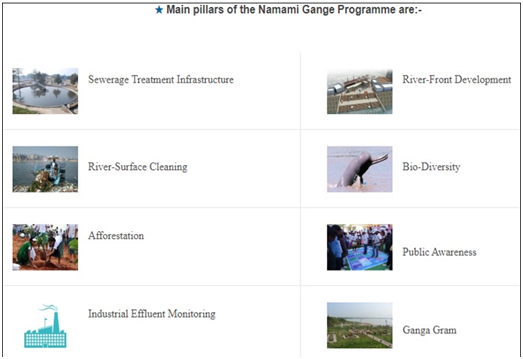Why in news?
- As per one report, National Mission for Clean Ganga (NMCG) has, so far, installed treatment plants capable of treating just 20% of the sewage estimated to be generated in the five major States that lie along the river.
What’s in today’s article?
- About Namami Gange Programme
- What are the Key Achievements under the Programme?
- News Summary
About Namami Gange Programme:

- It is an integrated conservation mission, approved as ‘Flagship Programme’ by the Union Government in 2014 with budget outlay of Rs.20,000 Crores.
- It is administered by the Ministry of Jal Shakti's Department of Water Resources, River Development and Ganga Rejuvenation, to accomplish the twin objectives of -
- Effective abatement of pollution,
- Conservation and rejuvenation of National River Ganga.
- The program would be implemented by the National Mission for Clean Ganga (NMCG), and its state counterpart organisations i.e., State Program Management Groups (SPMGs).
- NMCG is the implementation wing of National Ganga Council (NGC), which replaced the National Ganga River Basin Authority.
- NGC was created in 2016 under the River Ganga (Rejuvenation, Protection and Management) Authorities Order, 2016, and is headed by the PM.
- In order to implement the programme, a three-tier mechanism has been proposed for project monitoring comprising of:
- A high-level task force chaired by Cabinet Secretary assisted by NMCG at the national level,
- State level committee chaired by Chief Secretary assisted by SPMG at the state level and
- District level committee chaired by the District Magistrate.
- Its implementation has been divided into -
- Entry-Level Activities (for immediate visible impact),
- Medium-Term Activities (to be implemented within 5 years of time frame) and
- Long-Term Activities (to be implemented within 10 years).
What are the Key Achievements under the Programme?
- Creating Sewage Treatment Capacity: 98 sewage projects have been completed in the states of UK, UP, Bihar, Jharkhand, West Bengal, etc.
- Creating River-Front Development: The projects for the construction, modernisation, and renovation of 267 Ghats/Crematoria and Kunds/Ponds have been initiated.
- River Surface Cleaning: River Surface cleaning for collection of floating solid waste from the surface of the Ghats and River and its disposal are afoot and pushed into service at 11 locations.
- Biodiversity Conservation: Cadre of volunteers (Ganga Praharis) have been developed and trained to support conservation actions in the field
- Public Awareness: Ganga Praharis and Ganga Doots are engaged in spreading awareness through planting trees, cleaning ghats, Ganga Aarti, painting and poems.
- Industrial Effluent Monitoring: Regulation and enforcement through regular and surprise inspections of Grossly Polluting Industries (GPIs) is carried out for compliance verification against stipulated environmental norms.
- Deploying best available knowledge and resources across the world: Clean Ganga has been a perennial attraction for many international countries that have expertise in river rejuvenation.
News Summary: Seven years on, mission to clean the Ganga remains a work in progress
- So far, NMCG has installed treatment plants capable of treating just 20% of the sewage estimated to be generated in the five major States that lie along the river.
- The treatment plants will be capable of treating 60% of sewage by December 2026.
- Projects to set up sewage treatment plants(STPs) and sewerage networks are at the heart of the Namami Ganga mission, and account for about 80% of the overall project outlay.
- As of July 2023, STPs capable of treating 2,665 MLD have actually been commissioned, and are now functional.
- The river’s water quality is now within prescribed limits of notified primary bathing water quality.
- A conspicuous sign of the improvement in water quality along the Ganga was a rise in the dolphin population — both adult and juvenile — from 2,000 to about 4,000.
- The NMCG is now working to develop a water quality index, on the lines of the air quality index, to be able to better communicate about river-water quality.
Challenges faced during project implementation
- Several plants took time to be commissioned as there were problems with land acquisition.
- In many instances, the Detailed Project Reports (DPRs) needed revision.
- DPRs prescribe all the steps necessary to execute a project, and the roles of agencies, Centre, State and the private contractors.
- Though NMCG is a ₹20,000 crore mission, the government has so far given in-principle approval for projects worth ₹37,396 crore.
- Of this, only ₹14,745 crore has been released to States for infrastructure work, as of June 2023.










